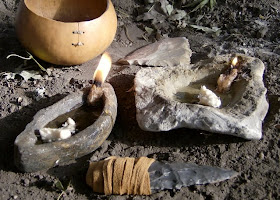Lately I've been 'under the weather' and haven't had a chance to do much. I finally got to the point I was so bored with being sick I went out to the rock pile and picked out an angular chunk of blue/black Fort Payne chert to play with. You find this type of mineral in northwestern Alabama. There are several variations of Fort Payne cherts. Native Americans have been using this resource since Paleo time to make cutting tools, scrapers, choppers, etc. Picking up an oblong quartz cobble (looks like I had pecked a groove in it as some point), to use as a hammerstone, I pictured the angle to strike thin blades. In a minutes time I had half a dozen sharp flake tools. To illustrate this, in the middle picture I used a flake to cut 1/4 inch stiff leather. These tools can be used as is, or with some modification, made into thumb scrapers, perforators, burins, etc. Nature provides, you just need to know how to use it.
Everyone needs something that gets them excited! I love primitive skills...welcome to my journey.
Saturday, October 24, 2009
Thursday, October 22, 2009
Monday, October 19, 2009
Fat Lamp

Pictured are a couple of fat lamps I use. The one on the right was pecked from a limestone slab, the other is chiseled from soapstone. I always save the fat from scraping deer hides as fuel, but animal grease or vegetable oil would work. The wicks were simply cattail down rolled into a wick and wetted. Fat lamps were traced back to Ice Age Europe nearly 40,000 years ago and coincided with several other developments - art, personal adornments, and the dart & atlatl. This controlled use of fire allowed activities after sunset and in places naturally dark. These lamps are considered "closed curcuit" bowl lamps, in that they have a depression to catch and retain the fuel as it melts. This is the most common type found in all regions, in all periods, where fat lamps were used, and range from crude to elaborately carved. It is easy to let the mind wander in the evenings in camp, and picture animal skin clad men dabbing mineral pigments onto cave walls, in the flickering illumination of the lamp light.
Saturday, October 17, 2009
Lashing

Lately I've been watching the documentaries of Mark Anstice & Olly Steed living among the primtive peoples of West Papua - the Kombai and the Mek tribes. In most respects these peoples still live as there ancestors did hundreds, if not thousands, of years ago. They wear little clothing, chop down trees using stone axes, have essentially no written language, and live as hunter gatherers off of the bounty of the rainforest. One thing I noted is their use of rattan, a climbing type of palm with a long strong stem, to literally lash their world together. The Kombai live in treehouses, 30 to 40 feet up in the canopy, made with uncanny balance and skill, by lashing stone axe hewn limbs with rattan cords. The same fibers haft an ancient axeblade to a wooden handle. The Mek tribe worked as village to lash a new hut and construct a 100-foot long "monkey bridge" across a raging river to join two villages. Today lashing is considered of makeshift or temporary use, but it is among one of the oldest technologies of man. James E. Gordon in, The New Science of Strong Materials, said: "In pure strength, apart from their flexibility, the lashings, sewings, and bindings used by primitive peoples, and by the seamen down to recent times, are more efficient than metal fastenings." (Pictured are spear and adze hafted with rawhide cordage...which do not do justice to the simplicity and efficiency of the Kombai & Mek.)
Saturday, October 10, 2009
Eating Insects

The weather on the plains made a short gathering this weekend. It dropped about 3-4 inches of wet fluffy snow overnight. All was not lost, we still had a hardy sampling of roasted crickets and mealworm larvae. (Pictured are the leftovers...plenty of drumsticks to go 'round.) Not as bad as my prejudiced Western mind had anticipated. They sort of "melt in your mouth, not in your hands." Except for the crickets long hairlike ovipositor that sticks out of the females abdomen (used to deposit eggs into soil or plant stems). That tasty morsel tends to get stuck between the teeth, or lodged in your throat, inciting the gag reflex...lol. Eating insects is part of the everyday diet in some parts of Africa, Asia, and Latin America. Native Americans in the US feasted on roasted grasshoppers and were known to eat about 60 different varieties of insects. In Zaire, the mopanie worm is known as the "snack that crawls"...mmmm. There are about 1,462 recorded edible insects. Nutrition-wise, insects tend to rival fish and beef for protein, vitamins, and calories. All in all, knowing these facts did not curb my imagination when taking the first bites. All I could think of was an episode of "Man versus Wild", where Bear bites into a grub the size of your thumb - and guts and juice go spurting and run down his chin...>gag<.



